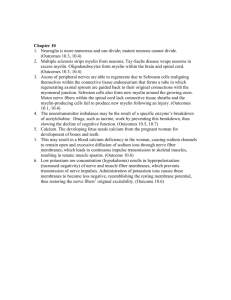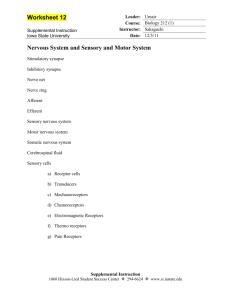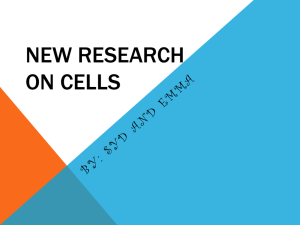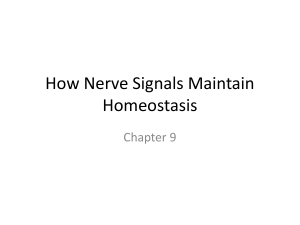NERVE
advertisement
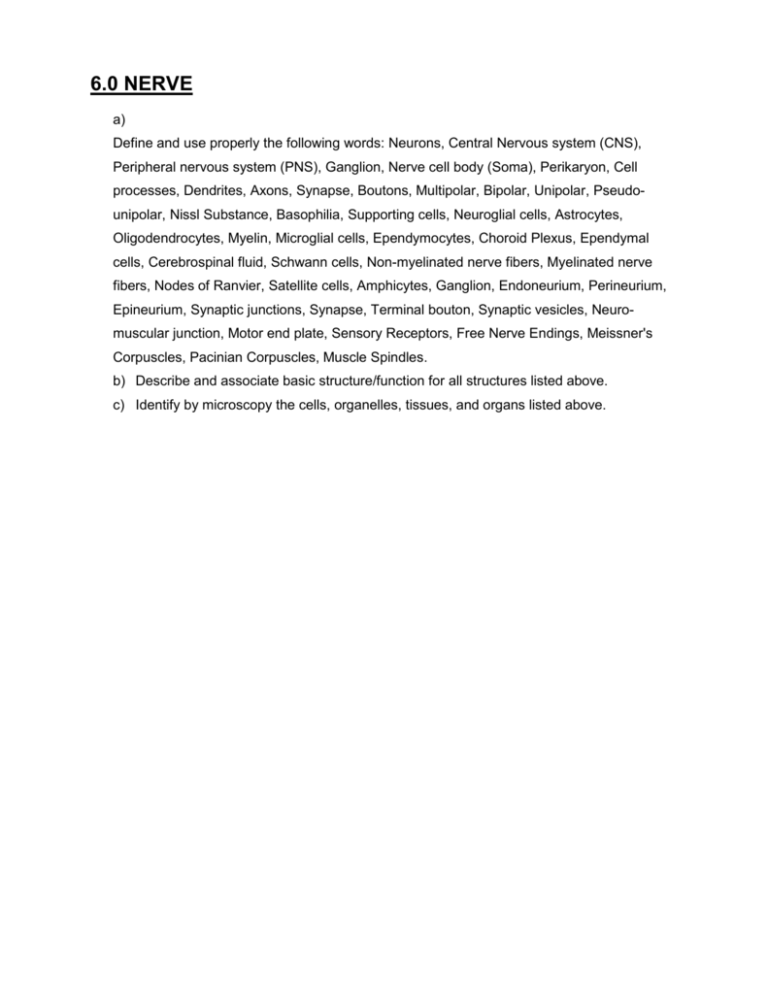
6.0 NERVE a) Define and use properly the following words: Neurons, Central Nervous system (CNS), Peripheral nervous system (PNS), Ganglion, Nerve cell body (Soma), Perikaryon, Cell processes, Dendrites, Axons, Synapse, Boutons, Multipolar, Bipolar, Unipolar, Pseudounipolar, Nissl Substance, Basophilia, Supporting cells, Neuroglial cells, Astrocytes, Oligodendrocytes, Myelin, Microglial cells, Ependymocytes, Choroid Plexus, Ependymal cells, Cerebrospinal fluid, Schwann cells, Non-myelinated nerve fibers, Myelinated nerve fibers, Nodes of Ranvier, Satellite cells, Amphicytes, Ganglion, Endoneurium, Perineurium, Epineurium, Synaptic junctions, Synapse, Terminal bouton, Synaptic vesicles, Neuromuscular junction, Motor end plate, Sensory Receptors, Free Nerve Endings, Meissner's Corpuscles, Pacinian Corpuscles, Muscle Spindles. b) Describe and associate basic structure/function for all structures listed above. c) Identify by microscopy the cells, organelles, tissues, and organs listed above. 4.0 NERVE INTRODUCTION Neurons are cells of the nervous system: action potentials are transmitted to other neurons and target organs I. DIVISION OF THE NERVOUS SYSTEM -Central Nervous system (CNS) -Peripheral nervous system (PNS) A. CENTRAL NERVOUS SYSTEM 1. most nerve cell bodies reside within the CNS 2. exceptions are the primary sensory neurons and effector neurons of the autonomic nervous system (nerves supplying the gut; the enteric nervous system) B. PERIPHERAL NERVOUS SYSTEM 1. A ganglion is a collection of nerve cell bodies & nerve fibers outside the brain or spinal cord (CNS) 2. The PNS is found within organs and tissues outside of the CNS 3. PNS neurons and support cells are surrounded by connective tissue II. NEURONS A. Basic Structure 1. Nerve cell body (Soma): nucleus & Perikaryon (cytoplasm) 2. Cell processes: a. dendrites - numerous, receive stimuli b. axons - single projections that terminate on other neurons or target organs c. synapses : i. tapering processes that end or terminate as synaptic terminals (boutons) on tissues (sensory) or ii. synapse with other neurons (axons, dendrites or the cell body). B. Classification by shape and number of processes 1. Multipolar (CNS); many dendrites; single axon (e.g., motor neuron) 2. Bipolar (sensory): 1 dendrite; 1 axon 3. Unipolar: Only developmental 4. Pseudo-unipolar: axon and dendrite with a common origin (sensory) C. Morphological features of neurons 1. Light microscopy a. Large nucleus b. Nissl Substance: RER; basophilia c. RER does not extend into axons d. axons are eosinophilic e. present (high turnover of materials due to high metabolic rate); could indicate a pathologic condition D. Electron microscopy 1. prominent nucleolus 4. RER (1/3 of proteins are renewed daily) 5. mitochondria (brain utilizes 20% of blood glucose) 6. numerous microtubules and filaments in parallel bundles (neurotransmitter substances transported) 7. lipofuscin inclusion bodies accumulate with age III. SUPPORTING CELLS (NON-NEURONAL) A. CENTRAL NERVOUS SYSTEM SUPPORTING CELLS (NEUROGLIAL CELLS): 1. Astrocytes a. Protoplasmic Astrocytes in grey matter i. many short branches b. Fibrous Astrocytes in white matter i. Fewer straight processes ii. Terminate on capillaries iii. Act like fibroblasts following injury iv. lay down neuropil (extracellular matrix) 2. Oligodendrocytes a. form myelin sheaths: surrounds axons in CNS b. Myelin: Phospholipid membrane c. one cell can myelinate up to 50-nerve fiber d. found near nerve cell bodies 3. Microglial cells a. small size with irregular nucleus b. numbers are rare c. serve as macrophages 4. Ependymocytes a. cuboidal epithelium lining the ventricles & spinal cord b. ciliated cells c. cells taper into fine branches that communicate with astrocytes but have no basal lamina 5. Choroid Plexus a. a mass of capillaries projecting into the ventricles b. these are modified ependymal cells that line the capillaries but have no basal lamina c. cerebrospinal fluid secretion occurs here B. PERIPHERAL NERVOUS SYSTEM SUPPORTING CELLS 1. SCHWANN CELLS (like the oligodendrocyte) a. Non-myelinated nerve fibers: i. Schwann cell cytoplasm contains mitochondria and microtubules ii. Schwann cell cytoplasm from one cell surrounds many small axons b. Myelinated nerve fibers: i. Concentric layers of the Schwann cell membrane: larger axons ii. One cell surrounds only one axon iii. NODES OF RANVIER are depressions in the myelin where two Schwann cells meet 2. SATELLITE CELLS (Amphicytes) a. small cells with heterochromatic nucleus b. surround the nerve cell bodies in PNS (Ganglion) IV. CONNECTIVE TISSUE OF NERVE A. Schwann cell produces: basal lamina & collagen fibrils B. Endoneurium: fibroblasts & capillaries surrounding Schwann cell and the immediate nerve fibers C. Perineurium: larger vessels & CT surrounding fascicles (bundles) D. Epineurium: consists of thicker CT and surrounds several nerve bundles V. SYNAPTIC JUNCTIONS --links neurons to neuron; neuron to organ A. Synapse (neuron to neuron) a. terminal bouton (swelling) b. releases neurotransmitters in the synaptic cleft area c. synaptic vesicles contain acetylcholine or norepinephrine, released by exocytosis d. Other organelles: mitochondria, microtubules, desmosomes B. Neuro-muscular junction (Motor end plate) (neuron to skeletal muscle) a. A foot process with folds forms the synaptic cleft b. Endoneurium is continuous with endomysium c. Schwann cell surrounds the end plate d. End plate area contains vesicles, RER, mitochondria e. The muscle region contains nuclei and mitochondria C. Sensory Receptors a. Free Nerve Endings i. found throughout the body; detect temperature, touch and pain b. Meissner's Corpuscles i. encapsulated nerve ending in the dermis of skin ii. plump oval cells surrounded by a CT capsule c. Pacinian Corpuscles i. large encapsulated sensory receptor ii. found deep in skin, ligaments, joint capsules iii. appear like a large onion in cross-section d. Muscle Spindles i. stretch receptors within skeletal muscle ii. sensory fibers loop around a small muscle fiber within a capsule of CT




